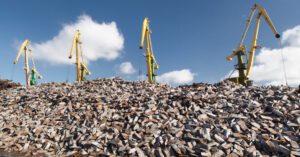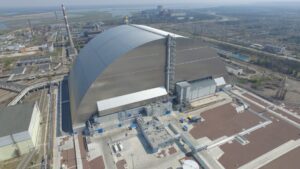
Oil is cheapening fast on Thursday morning after declining the day before. Investors are evaluating signals about increase of fuel reserves in the USA and statements of representatives of the Federal Reserve.
The cost of March futures on the Brent crude at London’s ICE Futures Exchange stood at $83.83 per barrel by 7:16 a.m., down $1.15 (1.35%) from the close of the previous session. At the close of trading on Wednesday those contracts fell by $0.94 (1.1%) to $84.98 per barrel.
The price of WTI futures for February at the electronic trading on the New York Mercantile Exchange (NYMEX) is $78.2 per barrel by that time, which is $1.28 (1.61%) lower than at the end of the previous session. The contract fell by $0.7 (0.9%) to $79.48 per barrel at the end of last session.
The day before oil had had a volatile session: during the trading quotations reached new highs since early December, but then went down on statements of James Ballard, head of Federal Reserve Bank of St. Louis.
Ballard told The Wall Street Journal that the U.S. central bank should continue raising the benchmark interest rate in order to get inflationary pressures down, despite recent statistical data pointing to a slowing economy.
“Such words have heightened fears that the Fed could raise the rate again by 50 basis points at its next meeting,” said Phil Flynn, senior market analyst at The Price Futures Group.
Moreover, the American Petroleum Institute (API) data, released Thursday night, showed a 7.6 million-barrel increase in U.S. oil inventories last week. A week earlier, reserves rose 14.87 million barrels.
The official report of the U.S. Department of Energy will be released Thursday at 6:00 p.m., a day later than usual due to the Martin Luther King Day holiday on Monday. Analysts polled by WSJ forecast that oil reserves fell by 1.1 million barrels for the week ended Jan. 13. The survey was conducted before the API data was released.

The ongoing decrease in physical flows of Russian natural gas through Ukraine and Turkey in January 2023 indicates that traders no longer see the risks of Europe passing this winter, the former head of the Ukrainian GTS Operator Serhiy Makohon said.
He wrote about it on his page in Facebook.
Application for transit of Russian gas through the Ukrainian GTS on January 19 reduced by 25% (8.2 million cubic meters) compared to January 18 – up to 24.4 million cubic meters, including in Europe goes 19 million cubic meters, the rest – to Moldova, said Makogon.
“This shows that Western traders do not see the risks of passing this winter, so they are not willing to import gas at any price. And when gas prices on stock exchanges fell to $600 per thousand cubic meters, traders refused to order additional volumes under existing long-term contracts with Gazprom in favor of purchase on the exchange,” explained the former head of UGTSU.
“And the Freeport LNG terminal, which is responsible for 20% of U.S. LNG exports and has been under repair since June, will also start working very soon. Therefore, Gazprom’s profits will clearly be unenviable. The russian energy blackmail did not pass,” he added.
As reported, since June 2022, the transit of Russian gas through Ukrainian GTS was about 42 million cubic meters, from January-2023 it began to gradually decline against the background of warm weather, high levels of stocks in the EU UGS and declined to a 16-month low stock prices in Europe.

Another temperature record was recorded in Kiev – for the first time in 143 years of observations, the average daily air temperature was +7.3 ° C, according to the website of the weather station of the Central Geophysical Observatory named after Boris Sreznevsky on Thursday.
“In Kiev, January 18, for the first time in 143 years of observations, the average daily air temperature was +7.3 ° C, which is 1.6 ° C above the record temperature value for the day in 1993. Climatic norm was exceeded by 9.8 ° C, which corresponds to the weather at the beginning of April”, – said meteorologists.
As noted in the report, the maximum temperature in the capital rose to +10.2 ° C, exceeding the previous record for 2007 by 0.8 ° C. The minimum temperature in Kiev did not fall below 3.7°C. The previous record was in 1990 and was 3,4°C.

Ukraine in 2022 reduced the export of pig iron in physical terms by 59% compared to the previous year – up to 1 million 325.275 thousand tons.
According to statistics released by the State Customs Service (SCS), during this period, the export of pig iron in monetary terms decreased by 61.1% – to $638.774 million.
In 2022, Ukraine imported 40 tons of cast iron worth $23 thousand, while in 2021 – 185 tons of cast iron worth $226 thousand.
Exports were mainly to the United States (38.47% of supplies in monetary terms), Poland (32.91%) and Turkey (8.12%), imports – from Germany (100%).
As reported, Ukraine in 2021 increased the export of pig iron in volume terms by 4.2% compared to 2020 – up to 3 million 235.772 thousand tons, the export of pig iron in monetary terms increased by 78.1% – to $ 1 billion 642.596 million. In this export was carried out mainly in the United States (53.61% of supplies in monetary terms), Italy (22.08%) and Turkey (9.74%).
In 2021, Ukraine imported 185 tons of cast iron worth $226 thousand from Germany (74.34%), Russia (20.35%) and Slovakia (5.31%), while in 2020, Ukraine imported 593 tons worth $417 thousand.

After opening a permanent mission of the International Atomic Energy Agency at the Pivdenno-Ukrainian NPP, such missions began their work at the Rivne NPP and in the Chernobyl NPP zone, said Rafael Grossi, director general of the agency.
“IAEA continues to expand its presence in Ukraine. Today I launched the IAEA Support and Assistance Mission in Chernobyl,” Grossi said on Twitter Wednesday.
He noted that agency specialists will remain at all Ukrainian nuclear power plants to provide vital nuclear safety assistance “during these difficult and challenging times.”
Earlier, the IAEA Director General announced the opening of a mission to the Rivne NPP.
For its part, the RNPP noted on Facebook on Wednesday that two IAEA nuclear safety and security experts remain at the RNPP site for a permanent mission.
“Their purpose will be to continuously monitor and control the nuclear and radiation safety of the power plant. The mission members will report on any threats that may be posed by military activities and will also keep in touch with the agency about the needs of the plant,” the report explains.
RAES Director General Pavel Kovtonyuk said he hopes IAEA’s permanent missions to nuclear power plant sites will not allow the aggressor country to disrupt the safety and physical protection of the power plants.
“The experts will also see the work of our personnel and equipment during probable attacks on the energy infrastructure. Our close liaison with the IAEA will emphasize the importance of security issues for nuclear power plants by international institutions and the UN,” Kovtonyuk commented, as quoted in the RAES report.
According to the head of Gosatomregulirovanie Oleg Korikov, cited in a report of RAEC, it is necessary to work out mechanisms of complete cessation of cooperation with Russia in the use of nuclear energy and mechanisms to limit the rights of Russia at the IAEA.
The RAEC specified that up to 12 experts of the agency would work at all Ukrainian nuclear power plants, which should become an important step in the work to assist Ukraine in the conditions of Russian aggression.
As it was reported, on 16 January, the IAEA mission started its work at the Pivdenno-Ukrainian nuclear power plant, and since September, the agency’s permanent mission has been working at the Russian-occupied Zaporizhzhia nuclear power plant. The decision to open an IAEA mission at the Khmelnitsky nuclear power plant was also announced.

Thirty-two countries have imposed restrictions in connection with an outbreak of coronavirus in China, the UN World Tourism Organization (UNWTO) said.
“By mid-January, 32 countries in the world have imposed special restrictions on tourist entry associated with travel from China. Most of them are Asian and European countries,” the report said.
According to the organization, this could slow the recovery of international tourism after the coronavirus pandemic, as China was the largest outbound tourism market in the world until 2020. In 2022, international tourist arrivals were reported to be only 63% of pre-pandemic 2019 levels.
On January 8, Chinese authorities lifted some of the restrictions on travel to the country for foreign tourists and the departure of its citizens abroad. However, due to the coronavirus outbreak in the country after abandoning the “zero tolerance for covid” policy, many governments began imposing entry restrictions on tourists who had visited China before traveling to their country. In particular, Japan, South Korea, India, the United States, Spain, Italy, and many other countries require such passengers to test negative for coronavirus or proof of vaccination, and some have introduced mandatory testing.